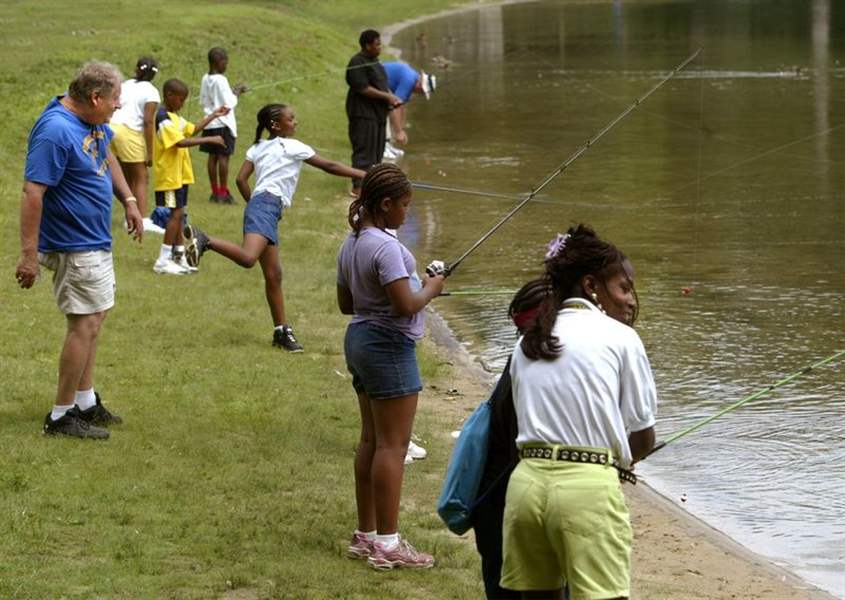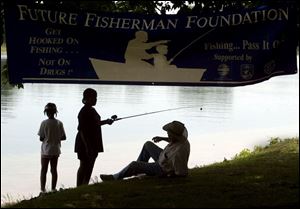
Hooked for good
7/13/2003
Volunteers help teach fishing at Olander Park as part of the National Youth Sports Program.
Allan Detrich
Somewhere between a four-pound largemouth bass leaping in last Sunday's sunset and a four-inch bluegill reeled to a sandy beach by a 10-year-old on Tuesday afternoon, something personally important happened.
It was a dawning, a powerful recollection of a lesson learned but sometimes forgotten or ignored: If we don't care about the future of fishing, and don't take our kids fishing, some day there will be no fishing.
That seems so obvious it need not be stated, but think about it. When was the last time you took a kid fishing? If you haven't done so yet this summer, don't let another week go by. Do it. Or don the vest of angling shame.
I probably would not be mulling over such thoughts had it not been for coincidence.
First, I had a really good time catching the aforementioned largemouth Sunday evening at a neighbor's farm pond. It was, as you know, hot and muggy. Shirtless and barefoot, I waded hip-deep into the sandy, shallow end of the pond to cool off and cast to the edges of the bankside cattails.
On the second cast of a froggy-finished top-water plug, after just a twitch or two of the line and a “bloop! bloop!” of the plug, the big bass rolled and slurped. The fish acted more like a smallmouth than a largemouth, leaping clear of the water twice and splashing back in a shower of droplets. But presently I brought it alongside, lipped it, unhooked it, spoke well of it, and returned it to the water with a big smile and chuckle of satisfaction.
Such an experience is a stand-alone pleasure in and of itself - which is the reason, I hope, most of us go fishing. But it only became part of the picture, a counterpoint, after Greg Kucharewski called on Monday. He wanted to know if I wanted to check out a Hooked on Fishing, Not on Drugs program for young people at Olander Lake the next day.
Next thing you know, I was standing alongside a 10-year-old girl on the Olander shore, helping, coaching, cheering, chatting. It was impossible to resist getting involved. The interest level of a busload of inner-city 10-year-olds on their first fishing trip was just too intense, the excitement too contagious.
It took me back to how I must have looked to Uncle Mike, way more than 40 years ago down on Rocky River in Cleveland. Hovering over that fishing rod, waiting for a “bite,” like a proverbial cartoon-vulture on a desert cactus, hanging over a hopelessly derelict soul as he crawls in search of water. Watching, biding time.
The kids in the HOFNOD program had that youthful intensity, that focus. Their eyes, full of anticipation, would lock on the bobber the instant it plopped on the water, like an English setter braced on a ringneck pheasant. Waiting, waiting, waiting for it to pop under the surface, to twitch, dance, move. To signal that a bluegill was trying to slip away with a worm dinner.

Noelle Reid, left, and Naquia Taylor get pointers from Walt Schuhmacher at Olander Park in Sylvania. Youngsters also have the opportunity during five-week sessions to experience swimming, dance, softball, volleyball, soccer and tennis.
The glee of the first fish, even a humble runt of a bluegill, is beyond telling. The rush to find “Doctor G,” so he could take a picture. The tentative fascination in laying the tiny fish in the palm of a small hand for a moment's admiration, of releasing it back to the lake ...
And questions. “Why do they have to be in there [worms, in a cooler]?” “Because if you don't [keep them cool] they turn to mush.”
I found myself not wanting the afternoon to be over. I kept wanting to see more of those I-got-one smiles, to hear the plentiful if quiet “thank-you's” when adult mentors would help bait a hook, to feel the tingle of the electricity.
Yes, I enjoyed the Sunday solitude of the pond and the bass, but Olander and the kids were better, priceless.
“Once they get out here, you can't get them to put the pole down,” said Delano Scott, one of the kids' mentors. Scott is a former University of Toledo football player, having suited up the last two years as a receiver and now entering his last academic year toward a degree.
“It's my third time fishing,” said Scott, a group leader in UT's National Youth Sports Program. “I wish I had a program like this when I was a kid.”
Indeed.
While my own involvement in the foregoing program may have been a coincidence, the NYSP endeavor at UT and its HOFNOD component are not.
NYSP is federally funded and is aimed at youths ages 10 to 16 from low-income families. It has been in place at UT for 35 years, making it one of the older such programs in the country, according to Dr. Ruthie Kucharewski, administrator and Greg's sister.
The NYSP sessions run for five weeks and also include opportunities to experience volleyball, basketball, swimming, tennis, soccer, dance, football and softball. Program notices are circulated through the community in churches, schools, libraries, youth groups and similar programs and organizations.

Volunteers help teach fishing at Olander Park as part of the National Youth Sports Program.
“The mothers will do whatever they can to sign their kids up,” said Kucharewski. NYSP handled some 500 youths this summer at UT. She explained that NYSP has a drug - and alcohol - -education component, and six years ago she applied to the Ohio Division of Wildlife for a grant for HOFNOD, which satisfies the drug and alcohol-education requirements.
Ohio, moreover, was a pilot state for development of the nationwide Water Works Wonders program, developed by the Recreational Boating and Fishing Foundation to increase awareness of and healthy participation in fishing and boating. Which helps explain the funding and support pipeline.
Greg Kucharewski of Brick, N.J., is a certified HOFNOD instructor with the Jersey Coast Anglers Association, and he volunteered to run the UT program on his vacations.
During about 21/2 days of HOFNOD, Greg teaches in-class skills in casting, baiting hooks, safety with tackle, boating safety and drug education. Then comes the “live” experience, fishing at the lake.
The state wildlife division donated small tackle boxes to each HOFNOD participant, and each this year went home with a new fishing rod-and-reel outfit. The Andersons donated 192 outfits, and donations by UT faculty and staff, NYSP board members and others allowed purchase of additional outfits.
“We had 25 volunteers from Merickel-Farley Trout Club to help the children,” Ruthie Kucharewski said. “It was outstanding. And [Lucas County] commissioner Maggie Thurber came out for almost two hours and helped the children learn to bait hooks and cast. She was terrific.”
So a new class of young fishers has been “graduated” from UT/NYSP/HOFNOD. They have their tackle boxes and fishing outfits.
The only other ingredients they need now are water and fish. And you.